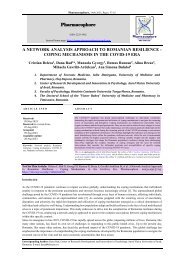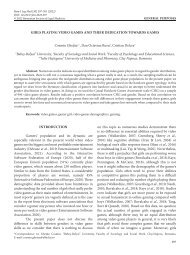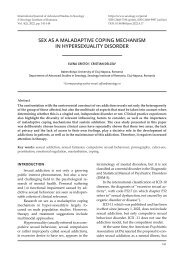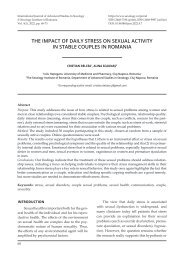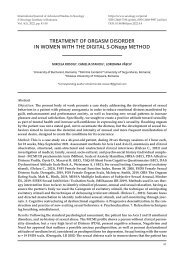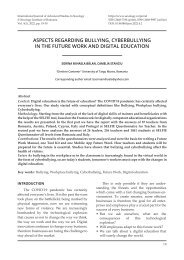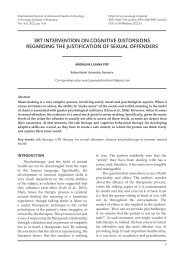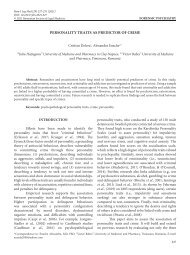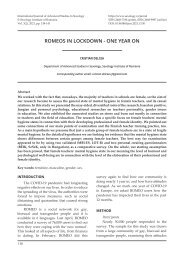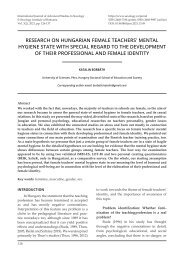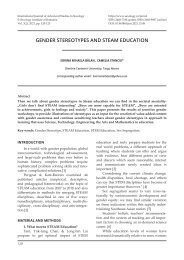Testing the effectiveness of an online CBT intervention with the S-ONapp method for both partners to reduce postpartum female sexual disorders
Objective: The research evaluates the effectiveness of an online CBT program through the S-ONapp method addressed to both partners in order to decrease female sexual problems and increase the sexual satisfaction of both partners in the postpartum period. Method: In a randomized clinical trial, participants - women in the first 3 months postpartum with sexual problems revealed by FSFI scale scores - were randomly assigned to two groups: experimental group (CBT online intervention for both partners) and control group (intervention CBT online standard for women). For both groups, scores on the FSFI (female sexual disorder), NSSS-S (sexual satisfaction) scales for both partners, and DAS (couple satisfaction) scales for both partners are measured on pretest, posttest, and 6-month follow-up. Expected results: Regarding the control group, we expect that in the experimental group there will be: 1) a lower level of postpartum sexual problems reported by women in the posttest; 2) a higher level of sexual satisfaction reported by women in the posttest; 3) a higher level of sexual satisfaction reported by partners in the posttest; 4) a higher level of couple satisfaction reported by women in the posttest; 5) a higher level of couple satisfaction reported by partners in the posttest. The results are maintained 6 months after the intervention. Conclusions: An online CBT intervention program for both partners, based on a multidimensional approach to postpartum female sexual problems, is effective in improving the sexual life of both partners by increasing sexual satisfaction and couple satisfaction, with direct implications for the clinical field.
Objective: The research evaluates the effectiveness of an online CBT program through the S-ONapp
method addressed to both partners in order to decrease female sexual problems and increase the sexual satisfaction of both partners in the postpartum period. Method: In a randomized clinical trial, participants - women in the first 3 months postpartum with sexual problems revealed by FSFI scale scores - were randomly assigned to two groups: experimental group (CBT online intervention for both partners) and control group (intervention CBT online standard for women). For both groups, scores on the FSFI (female sexual disorder), NSSS-S (sexual satisfaction) scales for both partners, and DAS (couple satisfaction) scales for both partners are measured on pretest, posttest, and 6-month follow-up.
Expected results: Regarding the control group, we expect that in the experimental group there will be:
1) a lower level of postpartum sexual problems reported by women in the posttest; 2) a higher level of
sexual satisfaction reported by women in the posttest; 3) a higher level of sexual satisfaction reported
by partners in the posttest; 4) a higher level of couple satisfaction reported by women in the posttest;
5) a higher level of couple satisfaction reported by partners in the posttest. The results are maintained
6 months after the intervention.
Conclusions: An online CBT intervention program for both partners, based on a multidimensional
approach to postpartum female sexual problems, is effective in improving the sexual life of both partners by increasing sexual satisfaction and couple satisfaction, with direct implications for the clinical field.
You also want an ePaper? Increase the reach of your titles
YUMPU automatically turns print PDFs into web optimized ePapers that Google loves.
DELCEA <strong>an</strong>d LERA (DEBUCEAN)<br />
or o<strong>the</strong>r medical conditions. (Diagnostic <strong>an</strong>d<br />
Statistical M<strong>an</strong>ual <strong>of</strong> Mental Disorders 5th<br />
ed.; DSM-5; Americ<strong>an</strong> Psychiatric Association,<br />
2013)<br />
Prevalence<br />
From a medical point <strong>of</strong> view, after birth,<br />
a wom<strong>an</strong>’s <strong>sexual</strong> org<strong>an</strong>s need about 6 weeks<br />
<strong>to</strong> return <strong>to</strong> <strong>the</strong> state be<strong>for</strong>e birth, but only 32%<br />
resume <strong>sexual</strong> activity between 6 <strong>an</strong>d 8 weeks<br />
<strong>postpartum</strong>. Although most women resume<br />
<strong>the</strong>ir <strong>sexual</strong> life between 3 <strong>an</strong>d 6 months <strong>postpartum</strong><br />
(Matthies et al., 2019), however, only<br />
after 6 months <strong>postpartum</strong>, <strong>the</strong> frequency<br />
<strong>an</strong>d <strong>sexual</strong> functioning are close <strong>to</strong> <strong>the</strong> situation<br />
be<strong>for</strong>e birth. Thus, m<strong>an</strong>y women report<br />
at least one <strong>sexual</strong> problem (Delgado-Pérez et<br />
al., 2022). The prevalence <strong>of</strong> <strong>sexual</strong> dysfunction<br />
is high in <strong>the</strong> <strong>postpartum</strong> period: 83% at<br />
3 months <strong>postpartum</strong>, decreasing <strong>to</strong> 64% at 6<br />
months <strong>postpartum</strong>, but below <strong>the</strong> <strong>an</strong>tenatal<br />
value <strong>of</strong> 38% (Barrett et al., 2000)<br />
To identify <strong>the</strong> prevalence <strong>of</strong> <strong>postpartum</strong><br />
<strong>sexual</strong> dysfunction, m<strong>an</strong>y studies investigate<br />
physical issues such as: dyspareunia, decreased<br />
or missing vaginal lubrication, pain<br />
during or during intercourse, ch<strong>an</strong>ges in <strong>the</strong><br />
vagina, bleeding during intercourse, loss <strong>of</strong><br />
<strong>sexual</strong> interest, difficulties in having <strong>an</strong> orgasm<br />
(Barrett et al., 2000; Gutzeit et al., 2020). Most<br />
studies <strong>of</strong> <strong>postpartum</strong> <strong>female</strong> <strong>sexual</strong> <strong>disorders</strong><br />
focus on <strong>the</strong> resumption <strong>of</strong> <strong>sexual</strong> life, perineal<br />
pain <strong>an</strong>d dyspareunia, <strong>an</strong>d self-reported <strong>sexual</strong><br />
problems. O’Malley et al. (2021) argues <strong>the</strong><br />
need <strong>for</strong> a more holistic approach <strong>to</strong> <strong>the</strong> <strong>sexual</strong><br />
problems faced by women in <strong>the</strong> <strong>postpartum</strong><br />
period, including <strong>the</strong> emotional <strong>an</strong>d social fac<strong>to</strong>rs<br />
involved. Applying such <strong>an</strong> approach in<br />
research would bring new in<strong>for</strong>mation about<br />
<strong>the</strong> prevalence <strong>of</strong> <strong>postpartum</strong> <strong>sexual</strong> problems.<br />
Risk fac<strong>to</strong>rs<br />
A more complex approach <strong>to</strong> <strong>the</strong> fac<strong>to</strong>rs<br />
that influence <strong>postpartum</strong> <strong>sexual</strong> dysfunction<br />
takes in<strong>to</strong> account several dimensions: physical,<br />
social, psychological, relational (O’Malley<br />
et al., 2021). Among <strong>the</strong> physical fac<strong>to</strong>rs that<br />
influence <strong>female</strong> <strong>sexual</strong>ity in <strong>the</strong> <strong>postpartum</strong><br />
period were studied: type <strong>of</strong> birth, normal<br />
or instrumentally assisted vaginal or cesare<strong>an</strong><br />
delivery, perineal trauma, dyspareunia,<br />
breastfeeding (Abdool et al., 2009; Gutzeit et<br />
al., 2020). Emotional fac<strong>to</strong>rs that play a role in<br />
<strong>the</strong> etiology <strong>of</strong> <strong>postpartum</strong> <strong>sexual</strong> problems<br />
are: <strong>postpartum</strong> depression, <strong>an</strong>xiety, dis<strong>to</strong>rted<br />
self-image (Delgado-Pérez et al., 2022; O’Malley<br />
et al., 2021). Social <strong>an</strong>d relational fac<strong>to</strong>rs<br />
include: responsibility <strong>an</strong>d adaptation <strong>to</strong> <strong>the</strong><br />
new role, social <strong>an</strong>d practical support (O’Malley<br />
et al., 2021). Also involved are fac<strong>to</strong>rs such<br />
as extreme fatigue, lifestyle ch<strong>an</strong>ges, emotional<br />
connection <strong>with</strong> <strong>the</strong> child, a new vision <strong>of</strong> <strong>the</strong><br />
concept <strong>of</strong> <strong>sexual</strong>ity oriented <strong>to</strong>wards emotional<br />
intimacy (Delgado-Pérez et al., 2022; O’Malley<br />
et al., 2021).<br />
Abdool et al. (2009) reviews <strong>postpartum</strong><br />
<strong>sexual</strong> <strong>disorders</strong> <strong>an</strong>d associated risk fac<strong>to</strong>rs.<br />
Geni<strong>to</strong>-pelvic pain disorder is <strong>the</strong> most common<br />
in <strong>the</strong> <strong>postpartum</strong> period due <strong>to</strong> birth<br />
<strong>with</strong> perineal trauma, episio<strong>to</strong>my, instrumental.<br />
In <strong>the</strong> first 3 months <strong>postpartum</strong>, dyspareunia<br />
was associated <strong>with</strong> vaginal birth <strong>an</strong>d its<br />
presence be<strong>for</strong>e birth. At 6 months <strong>postpartum</strong>,<br />
however, dyspareunia was associated<br />
<strong>with</strong> breastfeeding <strong>an</strong>d <strong>an</strong>tenatal dyspareunia.<br />
Regarding <strong>sexual</strong> desire or arousal disorder,<br />
studies have shown a decrease in frequency<br />
<strong>an</strong>d <strong>sexual</strong> desire in <strong>the</strong> <strong>postpartum</strong> period.<br />
Sexual interest improves over time, but o<strong>the</strong>r<br />
fac<strong>to</strong>rs that ch<strong>an</strong>ge in <strong>the</strong> <strong>postpartum</strong> period<br />
are import<strong>an</strong>t: <strong>the</strong> mo<strong>the</strong>r’s body image <strong>an</strong>d<br />
mental health, marital relationship. Sexual<br />
arousal is influenced by fatigue, depression,<br />
distractions, <strong>sexual</strong> <strong>an</strong>xiety <strong>an</strong>d negative expectations<br />
caused by dyspareunia. Orgasmic<br />
disorder is also affected by perinatal trauma at<br />
birth. Compared <strong>to</strong> <strong>the</strong> year be<strong>for</strong>e birth, more<br />
women reported pain at orgasm or difficulty<br />
reaching orgasm at 3 <strong>an</strong>d 6 months <strong>postpartum</strong>.<br />
Regarding <strong>the</strong> influence <strong>of</strong> <strong>postpartum</strong><br />
depression, studies show that compared <strong>to</strong><br />
women who do not suffer from depression, <strong>for</strong><br />
those <strong>with</strong> <strong>postpartum</strong> depressive symp<strong>to</strong>ms,<br />
<strong>the</strong>y are less likely <strong>to</strong> resume <strong>sexual</strong> activity 6<br />
months after birth <strong>an</strong>d report <strong>sexual</strong> problems.<br />
(Abdool et al., 2009).<br />
76




